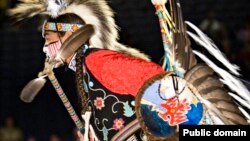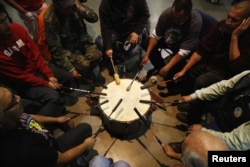It’s pow wow season in the United States, a time when Native American nations, bands and tribes gather to connect, celebrate tribal histories and cultures, and express their patriotism. On any given weekend this summer, a pow wow is taking place somewhere in the country, an expression of unity within and between Native communities.
“Pow wow” derives from an old Algonquian word that referred to a gathering of spiritual healers celebrating successful hunts, battles or trade. In 1883, the government banned “old heathenish dances,” worried they would “stimulate the warlike passions” of tribal youth.
Tribes found ways around the ban, which was lifted in the 1930s. The Confederated Salish and Kootenai Tribes of northwest Montana held pow wows as Fourth of July celebrations. Other tribes held pow wows as cultural displays for non-Natives.
Becky Olvera Schultz, an artist and writer of Azteca and Kickapoo heritage, said all pow wows revolve around dance, and central to dance is the drum.
“The drum is the heartbeat of the pow wow,” she said. “’Drum’ refers to both a large instrument and the group of drummers and singers who provide the pulse for pow wow dances.”
The drum groups sing music of many different types, from war songs to religious. Many are sung in “vocables,” syllables without meaning that allow songs to be understood and shared between tribes.
Drums may include members of different tribes. Some well-known groups are in high demand and travel from one event to another to perform.
Honoring the warrior
All pow wows open with the Grand Entry into the dance arena.
“The veterans head the Grand Entry, carrying flags and eagle staffs,” Schultz said. Wrapped in animal skin and trimmed with eagle feathers, the staff is a sacred symbol of its tribe or nation.
Dignitaries, chiefs, princesses, elders and pow wow organizers follow the veterans during the Grand Entry.
"Then come the male dancers, in different categories and age groups, and then the women dancers in theirs,” explained Schultz. Once everyone is assembled in a central arena, a song is sung to honor the veterans and a prayer is said to open the dancing.
All activities are presided by an emcee, who announces events and introduces dancers.
“Competition pow wows, which are usually larger, have a purse, prize money, and some of them are quite large. A lot of the dancers will go from pow wow to pow wow, and some of them win a good amount of money,” she said.
Dance
Men, women and children dance in several categories, which have evolved as a blend of traditions from different tribal nations.
The men’s Fancy Dance, for example, is a colorful and energetic dance in which men wear feathered bustles. Men’s Grass dancers wear regalia trimmed with fringe or ribbons which represent the movement of windblown prairie grass.
Women may dance the Fancy Shawl, wrapped in fringed shawls.
“They swing around and hold their shawls out,” said Schultz. “The purpose is to make the fringe sway back and forth. It’s very pretty and fluid.”
Alorha Baga, a member of the Rosebud Lakota tribe, is a competitive jingle dancer who now lives in California. She said jingle dancing originated in the early 20th century as a healing dance among the Northern Ojibwe, or Chippewa tribe.
“An elder was trying to figure out a way to cure an ailing woman named Maggie White. He was gifted a vision, and in that vision, he was told exactly what to do."
At first, Baga explained, Maggie was too ill to move. But as tribal women danced, Maggie began getting better.
“And by the time they were finished, she was cured,” said Baga.
The jingle dress is decorated with beadwork, ribbons and the rolled lids of old tobacco tins. Suspended by ribbons, they produce the sound for which the dance is named (see video below).
Today, Baga not only performs at pow wows but teaches the dances to children.
“Part of our teaching of pow wow dancing is making sure that our children and even adults know how these dances came to our tribes, their origins and their histories,” she said.
Pow wows may take place over two or three days, attracting large crowds and generating substantial income.
“I don't dance at pow wows, but I attended all my life and I am 60 years old now,” said Pte Henchala Gleska, a grandmother and member of the Rosebud Lakota tribe. “We have the Rosebud Fair every year here on the reservation,” she said, “and everybody attends either for powwow, the rodeo, mud racing or bread-making contests.”
And, she added, the food.










